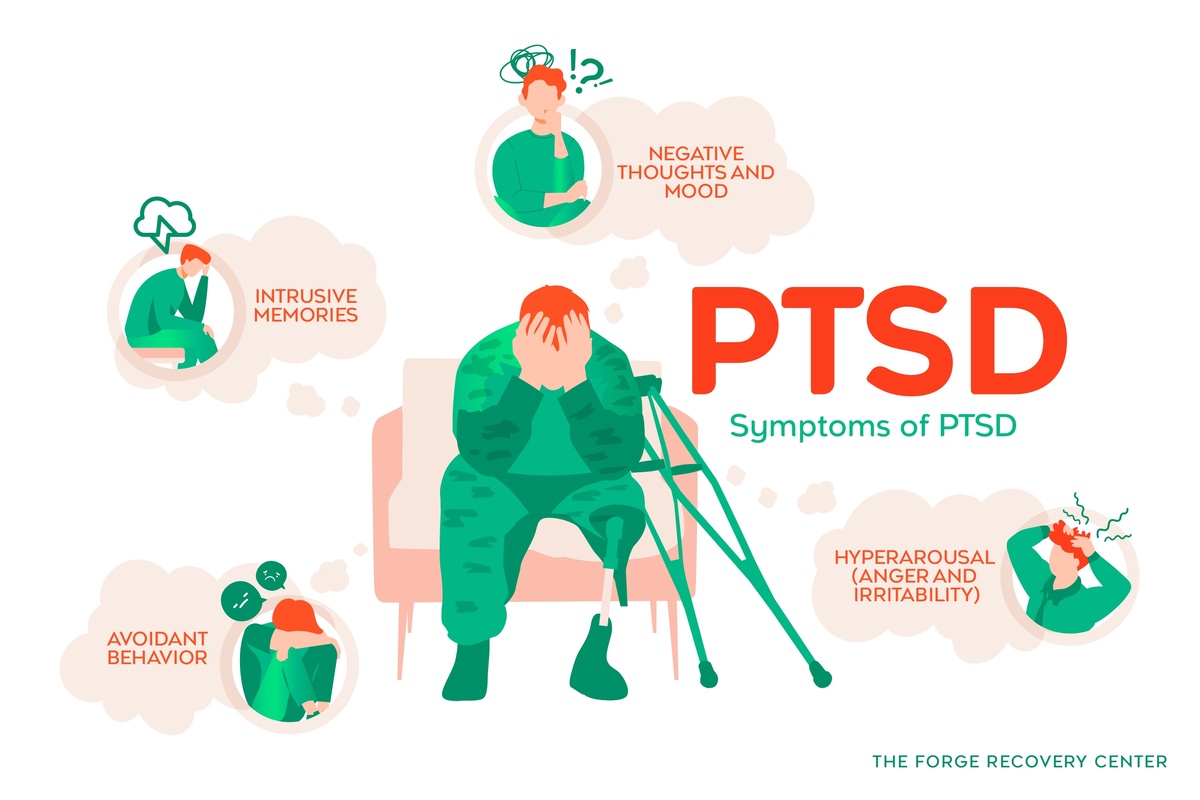PTSD: Understanding Post-Traumatic Stress Disorder, Its Treatment, & More


Living with PTSD can feel like navigating through a stormy sea, with waves of emotions crashing unpredictably. However, finding peace and stability is not an unattainable dream. By understanding the triggers and seeking the right support for this trauma disorder, managing PTSD becomes a journey toward healing and resilience.
Understanding PTSD: What Is Post-Traumatic Stress Disorder?
Post-traumatic stress disorder (PTSD) is a mental health disorder that can develop after experiencing or witnessing a traumatic event. This can include events such as natural disasters, physical or sexual assault, war, accidents, or other life-threatening situations.
According to the National Institute of Mental Health (NIMH), it affects approximately six out of every 100 U.S. adults each year.
Defining PTSD
Post-Traumatic Stress Disorder (PTSD) is a mental health condition that can develop after experiencing or witnessing a traumatic event. Individuals with PTSD often exhibit symptoms like persistent stress, fear, and anxiety even when the danger has passed.
PTSD is characterized by four main types of symptoms:
Intrusive memories
Avoidance behaviors
Negative changes in thinking and mood
Hyperarousal (feeling constantly on edge)
These symptoms can significantly impact a person's daily life, making it difficult to function at work or home and affecting relationships.
What Causes PTSD?
PTSD can stem from various traumatic events such as war, natural disasters, accidents, or abuse. The severity and nature of the trauma significantly impact the likelihood of developing PTSD. Onset timelines for PTSD vary among individuals, with some experiencing symptoms shortly after the event while others may have delayed reactions.
Who's at Risk for PTSD?
Populations at higher risk of developing PTSD include survivors of abuse, combat veterans, and individuals exposed to violence. Proximity to trauma and the relationship with the victim or perpetrator play crucial roles in determining the risk of PTSD. It's important to note that PTSD does not discriminate and can affect anyone regardless of age, including children.

Recognizing the Symptoms of PTSD
PTSD symptoms can vary greatly from person to person, and they may not appear immediately after a traumatic event. Some individuals may develop symptoms within the first few months, while others may experience delayed onset of symptoms years after the traumatic event.
Intrusive Memories
Intrusive memories are one of the hallmark symptoms of PTSD. These can include flashbacks, where a person relives a traumatic event, or distressing dreams and nightmares. They may also experience intrusive thoughts or images that cause intense emotional reactions.
Avoidance Behaviors
To cope with the overwhelming emotions and memories associated with their trauma, individuals with PTSD may try to avoid anything that reminds them of the event. This symptom can include avoiding people, places, or activities that trigger memories.
Emotional Signs: Negative Changes in Thinking & Mood
Emotional signs of PTSD can vary, including feelings of guilt, sadness, and anger. Individuals with PTSD may experience a pattern of emotional symptoms like avoidance of memories and negative beliefs. Moreover, anxiety, depression, and substance use are commonly linked to PTSD.
Physical Symptoms: Hyperarousal
Individuals with PTSD may also experience hyperarousal, which is a persistent state of feeling on guard and easily startled. These fear responses can be extremely disruptive.
They may also often exhibit physical symptoms like trouble sleeping and physical pain. The condition can also manifest physically through symptoms such as irritability and vigilance. It's essential to note that physical symptoms frequently coexist with emotional signs in those affected by PTSD.
Mood Symptoms
Children and teenagers may show different symptoms of PTSD than adults. They may exhibit regression behaviors, such as bed-wetting, or experience difficulties with schoolwork or social relationships.

Are You Struggling with Mental Health or Addiction?
We Can Help. Call Us Now!
CALL: 877-839-1772
Treatment Options: How Is PTSD Treated?
If you are struggling with symptoms of PTSD, it is essential to seek professional help. A mental health professional can provide a proper diagnosis and create an individualized treatment plan. Treatment for PTSD often includes a combination of therapy, medication, and support from loved ones.
Psychotherapy Techniques
Therapy is an essential aspect of treating PTSD.
Cognitive Behavioral Therapy (CBT)
Cognitive behavioral therapy (CBT) focuses on changing negative thought patterns to alleviate PTSD symptoms. It involves identifying and challenging distorted beliefs that contribute to anxiety and stress. CBT helps individuals develop coping strategies and improve their emotional regulation.
Key Points:
CBT targets maladaptive thinking patterns in individuals with PTSD.
The therapy aims to reframe traumatic experiences and promote healthier responses.
CBT has shown effectiveness in reducing PTSD symptoms like flashbacks and hypervigilance.
EMDR: Eye Movement Desensitization and Reprocessing
Eye movement desensitization and reprocessing (EMDR) is a psychotherapy approach that aids in processing distressing memories. By engaging in bilateral stimulation, such as eye movements or taps, individuals can reprocess traumatic events. EMDR helps desensitize triggers associated with PTSD.
Key Points:
EMDR helps individuals integrate traumatic memories into their past experiences.
The therapy assists in reducing the emotional intensity linked to traumatic events.
EMDR has demonstrated success in alleviating symptoms like intrusive thoughts and nightmares.
Medication Choices
Various medications are utilized to manage PTSD symptoms, including antidepressants, anti-anxiety drugs, and prazosin for nightmares. These medications target different aspects of PTSD, such as mood regulation, anxiety reduction, and sleep disturbances.
It's crucial for individuals to work closely with healthcare providers when considering medication options.
Key Points:
Medications can aid in decreasing fear, anxiety, and depression associated with PTSD.
The effects of medications may vary from person to person and require careful monitoring.
Healthcare providers play a vital role in adjusting medication dosages based on individual responses.

Importance of Support in Treating PTSD
Living with PTSD can feel extremely isolating, and having a strong support system is crucial for recovery. Friends and family can provide emotional support, understanding, and encouragement to seek professional help.
Family Role
Family members play a crucial role in supporting individuals with PTSD. They can provide emotional support, understanding, and a sense of security. Understanding the challenges faced by their loved ones is essential for effective support.
Empathy from family members creates a safe space for individuals with PTSD to express their feelings without judgment. Empathetic responses validate their experiences and emotions, fostering trust and emotional healing.
Open communication within the family unit helps in addressing triggers and managing symptoms effectively. Patience is key as individuals with PTSD navigate their recovery journey, requiring consistent support from their families.
Peer Support
Peer support offers valuable benefits for individuals with PTSD. Connecting with others who have gone through similar experiences provides a sense of belonging and validation.
Interacting with peers who understand the struggles of living with PTSD can reduce feelings of isolation and promote healing through shared experiences. Peer support groups create a supportive community where individuals feel understood and accepted.
Engaging in peer support activities encourages social interactions, which are vital for mental well-being. These interactions help in building coping strategies, resilience, and a sense of empowerment among individuals dealing with PTSD.
Support Groups
Support groups offer a safe space for individuals to connect with others who are facing similar challenges. Participating in a support group can provide validation and hope, and help individuals learn from the experiences of others.
Self-Care
Self-care is also crucial for managing PTSD. This can include activities such as exercise, mindfulness practices, or engaging in hobbies and interests. Taking care of one's physical and mental well-being can improve symptoms and promote healing.

Preventing PTSD: Treating PTSD Quickly
While not all traumatic events can be prevented, there are ways to build resilience and reduce the risk of developing PTSD. Some strategies include connecting with a support system, practicing self-care, and seeking professional help if needed.
Early Intervention
Early intervention plays a crucial role in treating PTSD. Recognizing symptoms early and seeking help can significantly improve long-term outcomes. Healthcare providers are instrumental in offering timely support to individuals struggling with PTSD.
Timely intervention can prevent the escalation of symptoms.
Seeking help early reduces the risk of long-term psychological impact.
Healthcare providers play a key role in identifying and addressing PTSD symptoms promptly.
Resilience Building
Building resilience is essential for individuals dealing with PTSD. Engaging in self-care practices, adopting healthy coping mechanisms, and having strong social support networks are vital components of resilience building. Resilience enables individuals to better manage and cope with the challenges of PTSD.
Self-care activities such as exercise and mindfulness can boost resilience.
Healthy coping mechanisms like journaling or art therapy aid in managing stress.
Social support from friends, family, or support groups fosters resilience and emotional strength.
Testing for PTSD
A healthcare professional may conduct a physical exam and psychological evaluation to diagnose PTSD. They may also use screening tools to assess symptoms.
Diagnostic Criteria
Mental health professionals diagnose probable PTSD by assessing specific criteria. Symptoms must persist for more than a month. These symptoms significantly disrupt daily life, including work and relationships. Seeking help from a qualified mental health professional is crucial for an accurate diagnosis.
Assessment Tools
Healthcare providers use various tools to assess combat veterans for PTSD. Questionnaires and interviews play a key role in evaluating symptoms. Accurate assessment is vital as it guides the development of effective treatment plans.
Are You Struggling with Mental Health or Addiction?
We Can Help. Call Us Now!
CALL: 877-839-1772
What Causes PTSD?
The development of PTSD is not fully understood; however, research suggests that a combination of genetic, environmental, and biological risk factors may play a role. Traumatic experiences can cause changes in the brain's structure and function, leading to symptoms of PTSD.
Genetics
Studies have shown that some individuals may be genetically predisposed to developing PTSD. Differences in the genes responsible for regulating stress hormones and neurotransmitters may be a risk factor for developing PTSD after a traumatic event.
Environmental Factors
Exposure to trauma is the most significant environmental risk factor in developing PTSD. Other factors such as childhood experiences, previous exposure to trauma, and a lack of social support can also contribute to the development of PTSD.
Brain Changes
Traumatic experiences can cause physical changes in the brain, particularly in areas responsible for processing emotions and memories. This may explain why individuals with PTSD have difficulty regulating their emotions and experience intrusive memories.
Biological Factors
Studies have also shown that individuals with PTSD may have imbalances in certain neurotransmitters, such as serotonin and dopamine. These imbalances can contribute to symptoms of depression, anxiety, and hyperarousal in individuals with PTSD.
Experiencing Trauma
While any traumatic event can potentially lead to PTSD, there are some types of events that have a higher risk. These include experiencing or witnessing violence, combat exposure, physical or sexual assault, and natural disasters.
It is important to note that not everyone who has experienced a traumatic event will develop PTSD. Certain risk factors, such as a history of mental illness, a lack of social support, and ongoing stress, may increase the likelihood of developing PTSD.

PTSD Triggers
Triggers are specific reminders that can cause a person with PTSD to experience intense emotional distress and physical symptoms. Triggers can be anything that reminds them of the traumatic event, such as sights, sounds, smells, or situations.
Identifying Triggers
Triggers in PTSD are specific stimuli that evoke intense emotional or physical reactions in individuals with the condition. These triggers often stem from past traumatic events and can manifest as sensory cues like certain smells, sounds, or visuals. Identifying triggers is crucial as it allows individuals to recognize and anticipate situations that may lead to distress.
Common triggers for individuals with PTSD include:
Loud noises resembling those heard during a traumatic event
Crowded spaces reminiscent of past traumatic situations
Specific dates associated with the traumatic experience
By pinpointing these triggers, individuals can better navigate their environments and implement strategies to prevent overwhelming emotional responses.
Recognizing triggers plays a pivotal role in managing PTSD effectively. By understanding what prompts distressing reactions, individuals can work towards avoiding such stimuli or developing coping mechanisms to mitigate their impact. This proactive approach empowers individuals to regain a sense of control over their emotions and responses.
Trigger Management
Managing triggers in individuals with PTSD involves a multi-faceted approach that combines therapy, self-care practices, and healthy coping mechanisms. Therapy sessions, such as cognitive-behavioral therapy (CBT), help individuals identify and reframe negative thought patterns associated with triggers. Through counseling, individuals learn skills to manage stress and anxiety triggered by specific stimuli.
Coping mechanisms like deep breathing exercises, mindfulness techniques, or engaging in calming activities such as yoga or painting serve as effective tools for managing trigger-induced distress. These strategies provide individuals with avenues to redirect their focus and alleviate the intensity of emotional responses.
Avoiding triggers whenever possible is essential in preventing PTSD symptoms from becoming worse. Creating a safe environment free from known triggers can significantly reduce the likelihood of experiencing distressing episodes. Developing healthy coping strategies through regular exercise, adequate sleep, and maintaining social connections fosters resilience against trigger-induced reactions.
Are You Struggling with Mental Health or Addiction?
We Can Help. Call Us Now!
CALL: 877-839-1772
Complications of PTSD
The effects of PTSD can extend beyond the emotional and psychological realm. Individuals with PTSD may also experience physical symptoms, such as chronic pain, headaches, and gastrointestinal issues. They may also be at a higher risk for other mental health disorders, such as depression and substance abuse.
Physical Effects of PTSD
Chronic stress caused by living with PTSD can weaken the immune system and increase the risk of developing physical health problems. This makes it crucial for individuals with PTSD to seek treatment and find healthy ways to manage their symptoms.
Impact on Relationships
Living with PTSD can significantly impact relationships with family, friends, and partners. The constant emotional distress and hypervigilance can lead to strained interactions. Individuals may struggle to trust others, resulting in difficulties forming or maintaining close relationships. Communication breakdowns are common as those with PTSD may find it challenging to express their emotions effectively.
Some common challenges faced by individuals with PTSD in relationships include feelings of detachment, irritability, and difficulty in sharing their experiences. Partners and family members may struggle to understand the behaviors associated with PTSD, leading to conflict and misunderstandings. Establishing boundaries and seeking therapy together can help improve relationship dynamics.
Work-Related Issues
For individuals with PTSD, work-related challenges are prevalent. Symptoms such as flashbacks, nightmares, and anxiety can interfere with concentration and productivity at work. Maintaining a consistent work schedule may become difficult due to triggers or overwhelming emotions experienced in the workplace. This can lead to absenteeism or decreased performance levels.
Workplace accommodations play a crucial role in supporting employees with PTSD. Employers should provide a safe and understanding environment where individuals feel comfortable disclosing their condition.
Flexible work hours, quiet spaces for breaks, and access to mental health resources can greatly benefit employees managing PTSD symptoms at work. Colleagues' awareness and support also contribute significantly to creating a supportive work culture for individuals with PTSD.

Seeking Help for PTSD
If you or a loved one is living with PTSD, it is essential to seek professional help. A mental health professional can provide a proper diagnosis and create an individualized treatment plan to address symptoms and promote healing.
Finding Therapists
Finding therapists specializing in PTSD treatment is crucial for effective recovery. Start by seeking recommendations from your primary care physician or mental health professional. Look for therapists with experience and training in evidence-based therapies like Cognitive Behavioral Therapy (CBT) or Eye Movement Desensitization and Reprocessing (EMDR). These therapies have shown significant success in treating PTSD symptoms.
When seeking qualified therapists, consider their credentials, experience, and approach to therapy. Ensure they are licensed mental health professionals with expertise in trauma-focused treatments. It's essential to feel comfortable and understood during therapy sessions to establish a trusting relationship with your therapist. Therapy plays a vital role in helping individuals process traumatic experiences, develop coping strategies, and regain a sense of control over their lives.
Support Networks
Support networks are invaluable for individuals dealing with PTSD. Friends, family members, and support groups can offer emotional support, understanding, and encouragement during challenging times. Connecting with others who have similar experiences can provide a sense of belonging and reduce feelings of isolation often associated with PTSD.
Friends and family members can play a crucial role in providing a safe space for open communication and offering practical assistance when needed. Support groups allow individuals to share their stories, learn from others' experiences, and gain insights into different coping mechanisms. The empathy and validation received from support networks can enhance one's resilience and foster a sense of community.
Are You Struggling with Mental Health or Addiction?
We Can Help. Call Us Now!
CALL: 877-839-1772
Closing Thoughts
In understanding PTSD, recognizing symptoms, testing for triggers, exploring treatment options, emphasizing support, preventing complications, and seeking help, you have taken significant steps toward managing PTSD.
Remember, seeking help is not a sign of weakness but a courageous move toward healing. By educating yourself and those around you about PTSD, you contribute to creating a supportive environment that fosters recovery. Take charge of your well-being by prioritizing self-care and reaching out to professionals when needed.
Your journey to overcoming PTSD may have challenges, but with the right support and resources, you can lead a fulfilling life. Stay informed, stay connected, and most importantly, take care of yourself. Your mental health matters. Keep moving forward on your path to healing.
PTSD Therapy in Orange County, CA
Few disorders are as devastating as PTSD. Living with untreated PTSD isn't really living...it's survival. PTSD isolates you, literally trapping you in the past with traumatic memories. However, having PTSD means you're something different: a survivor.
The Forge Recovery Center effectively treats PTSD through a trauma-informed approach. This means that we understand the effects of trauma and how it impacts the mind, body, and spirit. Our team utilizes evidence-based techniques to help individuals work through their trauma and develop healthy coping mechanisms.
If you'd like to learn more about our PTSD treatment program, reach out to The Forge Recovery Center today.



